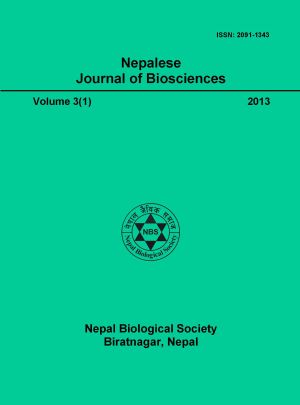Ecology of Typha domigensis Pers
DOI:
https://doi.org/10.3126/njbs.v3i1.41417Keywords:
Biomass diversity indices, productivity, turnover rate, turnover time, nutrients, germinationAbstract
In a shallow pond at Biratnagar, Nepal, importance value index of T. domingensis ranged between 134 (September) and 179 (May), and net primary productivity of the plant along with associated species was 1001.23 g/m2/yr. Maximum concentrations of nitrogen (2.76%) and potassium (2.87%) occurred in leaves, and phosphorus (0.95%) in roots of the plant in January, and three month old air-dried seeds of the plant had optimum germination (84%) under red light on moist filter papers. The pond water had minimum values of pH (6.12), turbidity (51.2 NTU), conductivity (5.39 ds/m), total dissolved solids (75.5 mg/l, nitrate and nitrite (0.01 mg/l) and potassium (5.6 mg/l) in September; total nitrogen (1.01 mg/l) in May; and ammonia (0.26 mg/l) and total phosphorus (0.72 mg/l) in January. The sediment (mud) of the pond was silty-sandy loam with annual averages of pH 6.6, nitrogen 0.23%, phosphorus 0.006%, potassium 0.04%, organic carbon 4.05% and C/N ratio 17.6:1.




